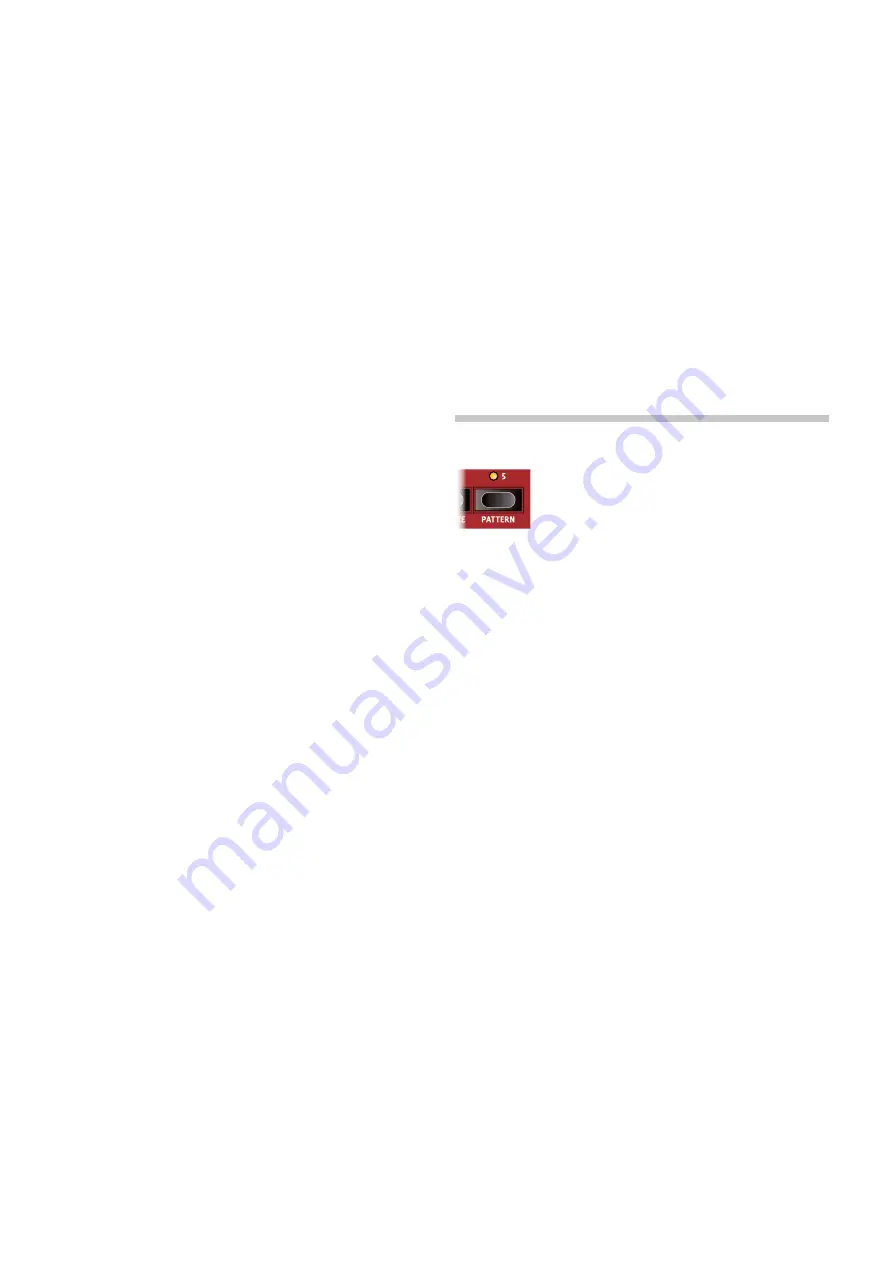
18 | nORD WaVe 2 USeR ManUal OS V1.0x
aRP (aRPeGGIaTOR)
In arp (arpeggiator) mode, held notes are played back consecutively,
outlining the played chord.
POlY (POlYPHOnIc aRPeGGIaTOR)
In Poly (Poly mode, notes are played back repeatedly, together. at larger
Range settings inversions of the held chord are played in order accord-
ing to the Direction setting.
GaTe (RHYTHMIc GaTe)
When set to Gate, the sound level of sustained notes is gated rhyth-
mically according to the Rate setting, and the selected Pattern if that
feature is active. The intensity or “hardness” of the gate is determined by
the Gate env (envelope) parameter.
PaTTeRn
all three arpeggiator/Gate modes can use the
PATTERN
setting (Shift +
arpeggiator mode). With Pattern On, the notes of the arpeggio or steps
of the gate conform to the rhythm defined by the selected pattern. Pat-
terns are selected or defined in the Pattern Menu (Shift + Program 5).
Read more about patterns on the following page.
DIRecTIOn
The direction of the arpeggio is set using the arpeggiator
selector but-
ton
. If no leD is lit, the arpeggio will play in the Up fashion. The other
directions are Down (
DN
), Up and Down (
U/D
) and Random (
RND
). This
parameter has no effect when using the Gate.
ZIG ZaG
With
ZIG ZAG
(Shift + arpeggiator Direction) activated, played notes will
jump by two steps and then back one, in a given direction.
RanGe / enV
The range which an arpeggio spans is determined by the
RANGE
knob.
at the 0 setting the arpeggio only uses the actual notes played on the
keyboard. In Poly mode this translates to the played note or chord
being retriggered and repeated as is. apart from the the values of even
octaves, ranging from 1-4, values between each octave can be used as
well for arpeggios ranging for example 2 octaves and a fifth.
When the
GATE
is active this knob controls the envelope (
ENV
) of the
Gate. at the zero position the envelope is very soft, producing a smooth
amplitude modulation. at the maximum position the envelope is very
“hard”, in effect turning the sound on and off in accordance with the
Gate tempo and pattern.
KB SYnc
In
KB SYNC
mode (Shift + Range/env knob), the arpeggiator or gate will
be reset any time a new note is played after all keys have been lifted.
With keyboard sync
off
, any new notes played while the arpeggio or
gate is running will conform to the “grid” of the current tempo setting.
When
MST CLK
is active, this KB Sync parameter determines whether
the Master clock is reset. This obviously affects all parameters synced
to the Master clock in the entire program.
Note that you can choose which layer or layers should reset the
Master Clock when played. For instance, an arpeggio sound on the
left side of a split could reset the clock when played, while a lead
sound on the right side of the split does not.
aRPeGGIaTOR TeMPO
The
TEMPO
knob sets the rate which will be displayed as quarter note
beats per minute (BPM) in the display. note that the arpeggiator plays
1/8 notes in the given tempo
aRPeGGIaTOR MaSTeR clOcK
Press
SHIFT
and turn the arpeggiator
TEMPO
knob to sync the arpeggio
with the nord Wave 2 Master clock. When the arpeggio is synchronized
to the Master clock, the Tempo knob is used for setting the arpeggio’s
subdivision of the tempo of the Master clock. The Subdivisions are
described in meter: 1/2 equals half notes at the clock tempo, 1/4 equals
quarter notes, 1/8 are eight notes etc. a “T” indicates a meter with triplet
feel.
Read more about the Master clock and how to set its tempo on page
14.
PaTTeRn
enter the
PATTERN
menu by pressing Shift + Program
5. apart from presenting a range of preset patterns, the
pattern editor can be used to create custom patterns
of varying length, in mono or using the stereo Pan func-
tion. Patterns can be used both with arpeggio and Poly
arpeggio as well as with the Gate mode. The two pages of the Pattern
menu are navigated using the
PAGE
3
/
4
buttons.
PaTTeRn PReSeTS anD STePS
There are a number of preset patterns, designed to provide both simple
and complex rhythms in both mono and stereo modes. These patterns
can be used as is, or selected and then customised using the Pattern
editor.
The
Steps
soft button is used for setting the number of steps in the
pattern, from 2 to 16.
PaTTeRn eDIT
Use the Pattern editor to define custom patterns, created from scratch
or based on one of the presets.
The
VALUE
dial is used to move back and forth in the pattern. at a given
position the available soft buttons can be used in the following way:
Press
Shift
and turn the dial to offset the pattern across the grid. This
can for instance be useful if the “one” of the pattern is not in the right
place, or for using permutations of the same pattern in different layers.
Acc
adds an
accent
to the selected step, indicated by a triangle above
the grid.
M
Note that in Arp or Poly mode, a parameter affecting velocity
sensitivity, such as Amp or Filter Velocity, needs to be active for the
accent to occur.
Press
Pan
to move the step between left, center and Right in the ste-
reo panorama.
Gate
is used for inserting or deleting steps, by pressing the button
once. To alter the length of a selected step press down on the button
and turn the dial.
Summary of Contents for Nord Wave 2
Page 40: ......






























